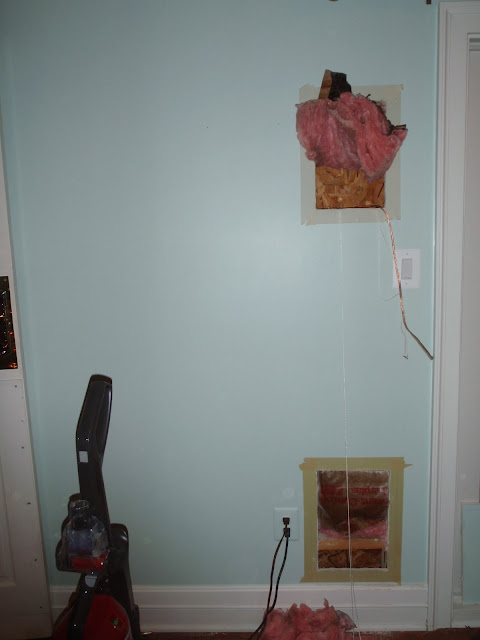It was a pretty big hassle fishing wires through the walls (see a couple of pictures below) and my son asked two questions:
- Why aren't all speakers wireless yet?
- Why aren't all speakers digital yet?
He was quite flabbergasted that there was an analog/powered signal traveling from the amplifier to the speakers in our setup (with the exception of the sub-woofer -- but that was still a line level analog signal).
Here are my thoughts as to why this is the state of affairs:
- There has to be significant advantages for making the change.
- For wireless: While there would be a huge advantage in terms of not having to fish the speaker wire through the wall, any advantage there is likely undone by the fact that you have to get 120 V (i.e., licensed electrician) power to the location.
- For digital: There would have to be a noticeable improvement in the sound to add the complexity of the D/A conversion to each speaker. I haven't read about this at all and don't know what sort of improvement is possible, but I'm guessing that its not substantial. I'd be willing to be challenged on this.
- The new technology would have to work as good as the wires its replacing. Remember when bluetooth audio first came out? The headphones were buggy and pretty much ruined the listening experience. It took years for the kinks to be fully worked out.
- A bit of an aside, but I will note that the subwoofer that I bought has the option to attach a wireless module to it (900 MHz, I think). After reading the reviews online, I was convinced that it was unlikely to work very well - and if it did, something could come along and mess with it in the future.
- There has to be standards for equipment makers - otherwise its just a mess for consumers. Perhaps somebody can be first and succeed with no standards (Sonos?) but I think it unlikely for the rest of the stereo/speaker industrial complex to latch on to standards for which they'll have to pay high (potentially very high) licensing fees for in the future.
- It can't cost substantially more than the equipment its replacing. There will certainly be a trade-off between installation labor costs and equipment costs, but it strikes me that the speakers and system can't cost way more than the existing options. Putting a high-quality D/A converter on each speaker would have to raise the cost.
I'm sure that I'm missing some of the reasons for this analog world still existing, but on the otherhand, perhaps this is a crazy big market opportunity for somebody.
Here are a few pictures of my pain:
Trying to drill on an outside wall is very much complicated by the presence of insulation!
To make this work, I had to cut a second hold to facilitate getting through the insulation. And I wouldn't have been able to do it (I don't think) unless I was willing to sacrifice some home security wires (for a system that I'm not using).
Done! (except for the lower drywall repair and some fresh paint - ok, fine, mostly done!)



No comments:
Post a Comment